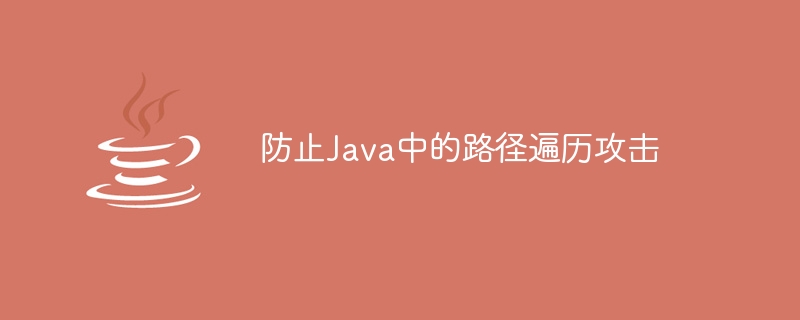防止Java中的路径遍历攻击

防止Java中的路径遍历攻击
随着互联网的迅猛发展,网络安全问题变得越来越重要。路径遍历攻击是一种常见的安全漏洞,攻击者通过操纵文件路径,获取系统信息、读取敏感文件或执行恶意代码。在Java开发中,我们需要采取合适的方法来防止路径遍历攻击。
路径遍历攻击的原理是利用不正确处理用户输入的文件路径导致的。下面是一个简单的示例代码来演示路径遍历攻击的工作原理:
import java.io.*;
public class PathTraversalDemo {
public static void readFile(String filePath) {
try {
File file = new File(filePath);
BufferedReader reader = new BufferedReader(new FileReader(file));
String line;
while ((line = reader.readLine()) != null) {
System.out.println(line);
}
reader.close();
} catch (IOException e) {
e.printStackTrace();
}
}
public static void main(String[] args) {
String userInput = "/path/to/sensitive/file.txt";
readFile(userInput);
}
}在上述示例代码中,readFile() 方法接收用户输入的文件路径,并尝试读取该文件的内容。然而,如果用户输入的文件路径包含特殊字符或目录遍历符号(如../),那么攻击者可能会读取任何文件,包括敏感文件。../),那么攻击者可能会读取任何文件,包括敏感文件。
为了防止路径遍历攻击,我们可以按照以下几点建议进行操作:
- 输入验证:在接收用户输入的文件路径之前,应该对其进行严格的验证。可以使用正则表达式或白名单过滤,确保文件路径只包含安全的字符和目录。
// 示例代码
public static boolean isSafePath(String filePath) {
// 使用正则表达式检查文件路径
String regex = "^[a-zA-Z0-9-_]+$";
return filePath.matches(regex);
}
public static void main(String[] args) {
String userInput = "/path/to/sensitive/file.txt";
if (isSafePath(userInput)) {
readFile(userInput);
} else {
System.out.println("Invalid file path!");
}
}- 文件路径正规化:使用Java提供的文件路径处理函数,如
canonicalFile()或getCanonicalPath()为了防止路径遍历攻击,我们可以按照以下几点建议进行操作:
- 输入验证:在接收用户输入的文件路径之前,应该对其进行严格的验证。可以使用正则表达式或白名单过滤,确保文件路径只包含安全的字符和目录。
// 示例代码
public static void readFile(String filePath) {
try {
File file = new File(filePath);
String canonicalPath = file.getCanonicalPath(); // 正规化文件路径
if (!canonicalPath.startsWith("/path/to/sensitive/")) {
throw new IllegalArgumentException("Invalid file path!");
}
BufferedReader reader = new BufferedReader(new FileReader(file));
// ...
} catch (IOException e) {
e.printStackTrace();
}
}canonicalFile()或getCanonicalPath(),可以将用户输入的文件路径规范化为绝对路径,并自动解决路径遍历问题。// 示例代码
public static void readFile(String filePath) {
try {
File file = new File(filePath);
if (!file.canRead()) {
throw new SecurityException("No permission to read file!");
}
BufferedReader reader = new BufferedReader(new FileReader(file));
// ...
} catch (IOException e) {
e.printStackTrace();
}
}以上是防止Java中的路径遍历攻击的详细内容。更多信息请关注PHP中文网其他相关文章!

热AI工具

Undresser.AI Undress
人工智能驱动的应用程序,用于创建逼真的裸体照片

AI Clothes Remover
用于从照片中去除衣服的在线人工智能工具。

Undress AI Tool
免费脱衣服图片

Clothoff.io
AI脱衣机

AI Hentai Generator
免费生成ai无尽的。

热门文章

热工具

记事本++7.3.1
好用且免费的代码编辑器

SublimeText3汉化版
中文版,非常好用

禅工作室 13.0.1
功能强大的PHP集成开发环境

Dreamweaver CS6
视觉化网页开发工具

SublimeText3 Mac版
神级代码编辑软件(SublimeText3)
 突破或从Java 8流返回?
Feb 07, 2025 pm 12:09 PM
突破或从Java 8流返回?
Feb 07, 2025 pm 12:09 PM
Java 8引入了Stream API,提供了一种强大且表达力丰富的处理数据集合的方式。然而,使用Stream时,一个常见问题是:如何从forEach操作中中断或返回? 传统循环允许提前中断或返回,但Stream的forEach方法并不直接支持这种方式。本文将解释原因,并探讨在Stream处理系统中实现提前终止的替代方法。 延伸阅读: Java Stream API改进 理解Stream forEach forEach方法是一个终端操作,它对Stream中的每个元素执行一个操作。它的设计意图是处













